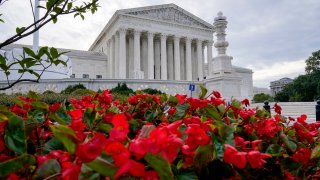
The Justice Department said Friday that the federal government will ask the Supreme Court to reverse a lower court decision on a restrictive Texas law that has banned most abortions since September. A federal appeals court on Thursday said the Texas law should stay in force while a Department of Justice lawsuit challenging the law proceeds through the courts. It's just the latest court action on the law, which is now headed for the Supreme Court for a second time.
Here are some questions and answers about the law and its path through the courts.
How exactly did Texas' law get to this point?
Texas' Republican Gov. Greg Abbott in May signed a law that bans abortions in Texas before many women even know they are pregnant. The law bans abortions once cardiac activity is detected, usually around six weeks. The law differs from similar efforts to restrict abortions in other states by leaving enforcement to private citizens, who can sue doctors or anyone who helps a woman get an abortion.
The law was challenged by abortion rights advocates before it went into effect in September, but its unique enforcement mechanism frustrated those efforts at the time. The law made one previous trip to the high court, which declined to intervene. After the law went into effect, the Biden administration filed a separate lawsuit challenging the law. It's that lawsuit that's now on track for the high court.
What happened previously when the law went to the Supreme Court?
The court let the law go into effect, voting 5-4 to deny an emergency appeal from abortion providers and others. The justices in the majority said “serious questions” had been raised about the law. But they cited a host of issues including the law's novel enforcement mechanism and the fact that no one had yet actually attempted to sue someone under the law for helping a woman get an abortion as among the reasons they declined to intervene. The majority stressed it was not making any conclusions about the constitutionality of the law.
Liberal justices and Chief Justice John Roberts dissented. Justice Sonia Sotomayor called her conservative colleagues’ decision “stunning.” Justice Elena Kagan wrote that the law was “patently unconstitutional,” and Justice Stephen Breyer said a “woman has a federal constitutional right to obtain an abortion during” the first stage of pregnancy.
What exactly happened most recently at the appeals court?
Get a weekly recap of the latest San Francisco Bay Area housing news. Sign up for NBC Bay Area’s Housing Deconstructed newsletter.
This time around, with the Biden administration's lawsuit, a federal judge in Texas put the law on hold. Judge Robert Pitman took Texas to task in a 113-page opinion, saying Republican lawmakers had “contrived an unprecedented and transparent statutory scheme” by trying to circumvent the courts.
“From the moment S.B. 8 went into effect, women have been unlawfully prevented from exercising control over their lives in ways that are protected by the Constitution,” wrote Pitman, who was appointed to the bench by former President Barack Obama.
Pitman's ruling allowed abortions to resume in Texas for a brief window before the 5th U.S. Circuit Court of Appeals temporarily halted it. A three-judge panel ruled 2-1 on Thursday to put a more lasting hold in place while the Biden administration lawsuit continues. As of now, Texas' law is in effect.
What happens now with the Texas abortion law?
The Justice Department said Friday it intends to appeal to the Supreme Court. There's no timetable for Supreme Court action, but it would take days or even longer for both sides to file briefs with the court, and then additional time for the court to act.
The court wouldn't be asked to rule on the constitutionality of the law at this point, just whether Texas should be allowed to enforce its law while the Biden administration's challenge continues.
The Supreme Court already has a major abortion case on its docket for December that could reshape abortion rights in America. What happens, in that case, could affect what ultimately happens in Texas.
How is it possible that Texas has such a restrictive abortion law?
Two major Supreme Court precedents, Roe v. Wade and Planned Parenthood v. Casey, prevent states from banning abortion before viability, the point at which a fetus can survive outside the womb. That happens around 24 weeks of pregnancy. But the Texas law's unique enforcement mechanism has made it hard to challenge.
What has been the impact of the abortion law in Texas?
Since the law took effect in early September, providers say 80% or more of abortions previously provided in the state are now prohibited. Texas women have sought out abortion clinics in neighboring states, some driving hours through the middle of the night and including patients as young as 12 years old. The law makes no exception in cases of rape or incest.



